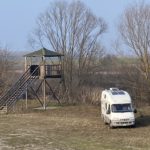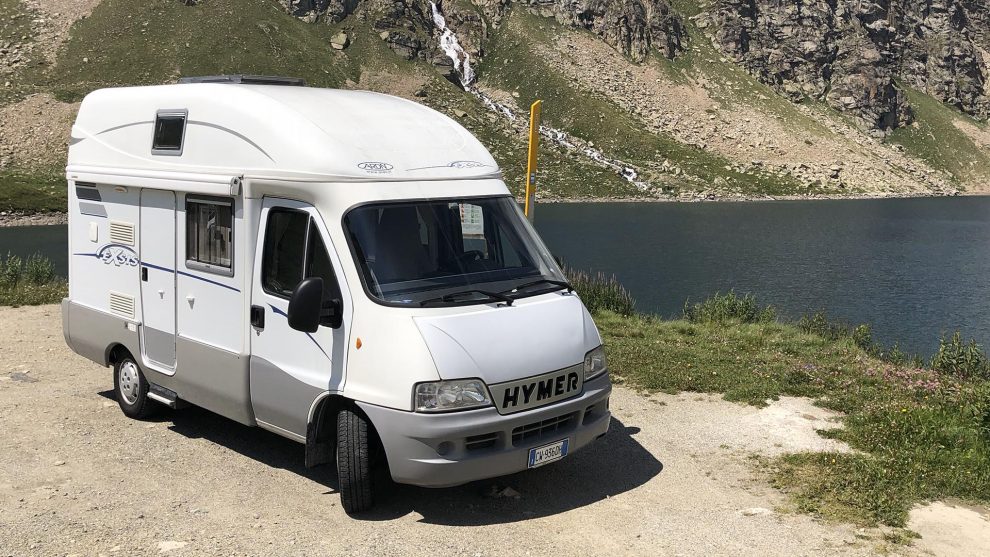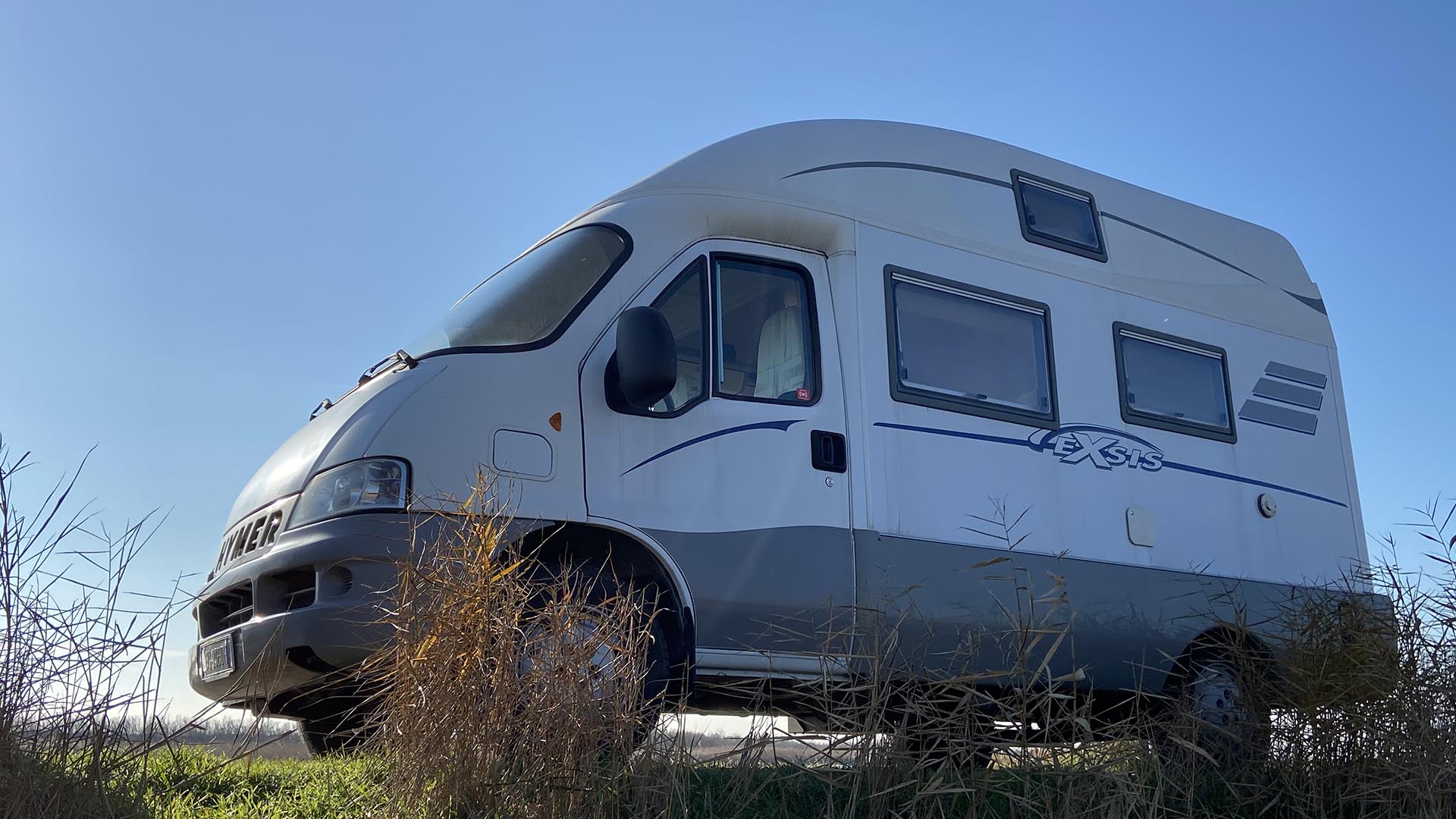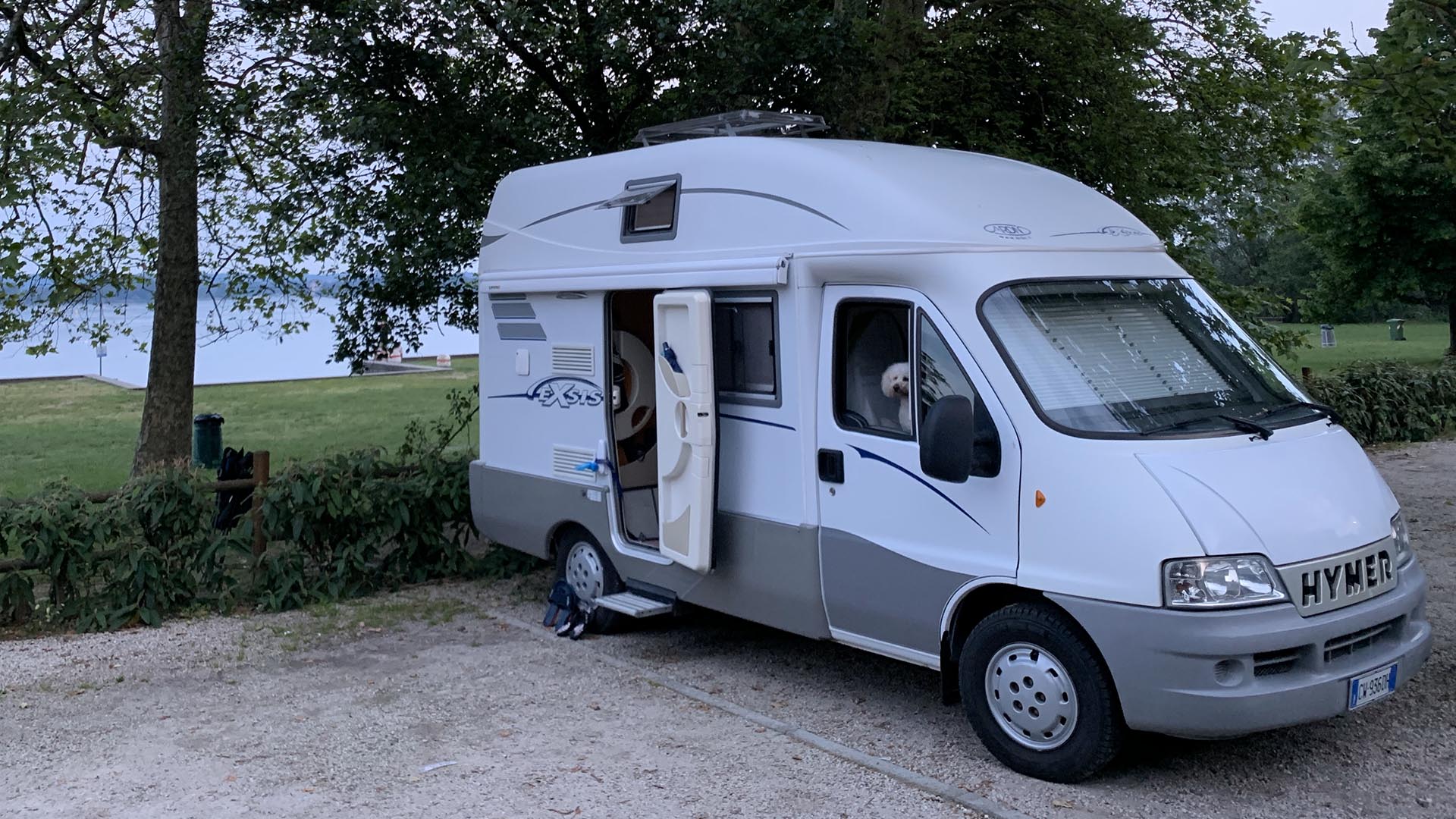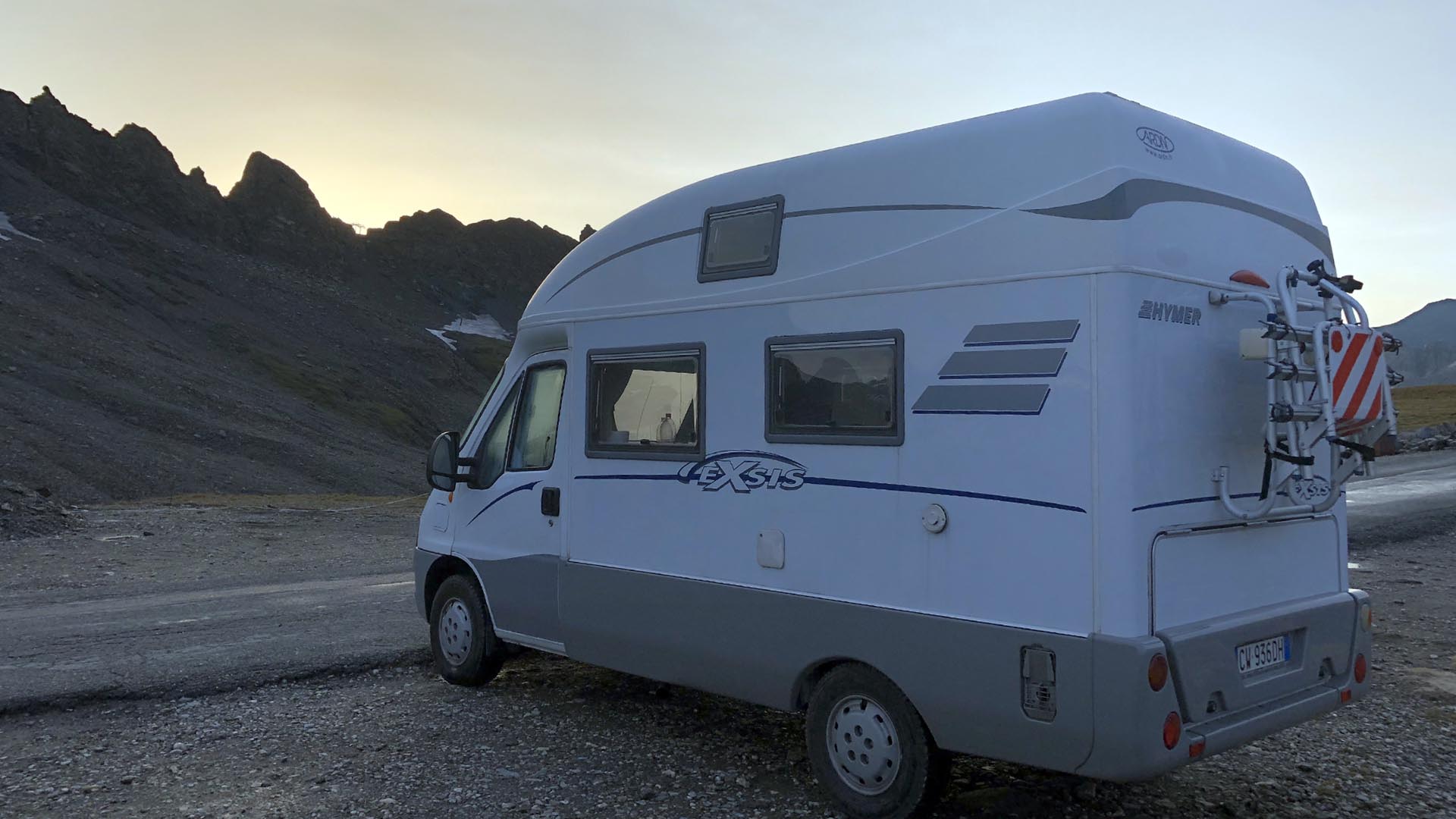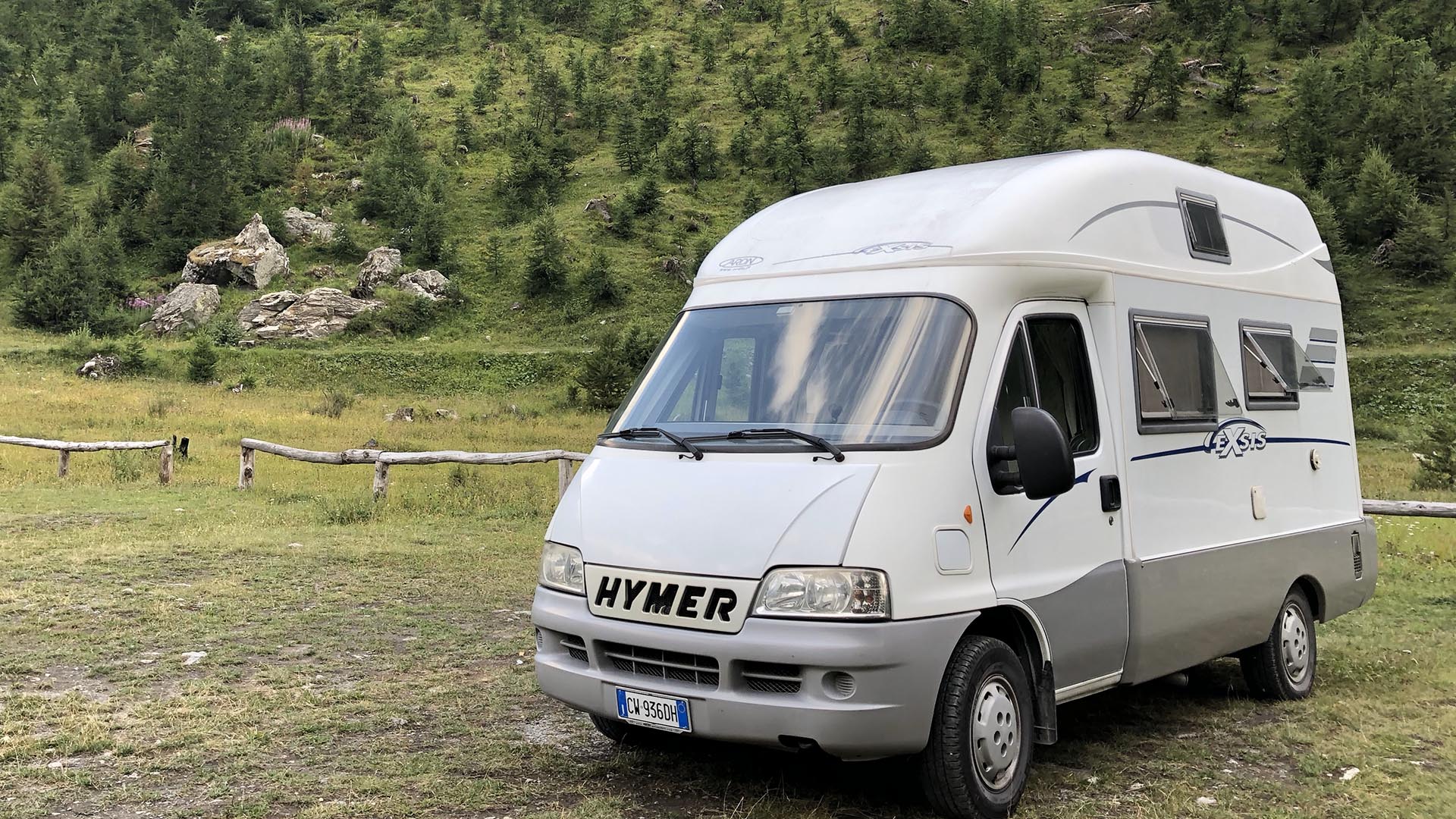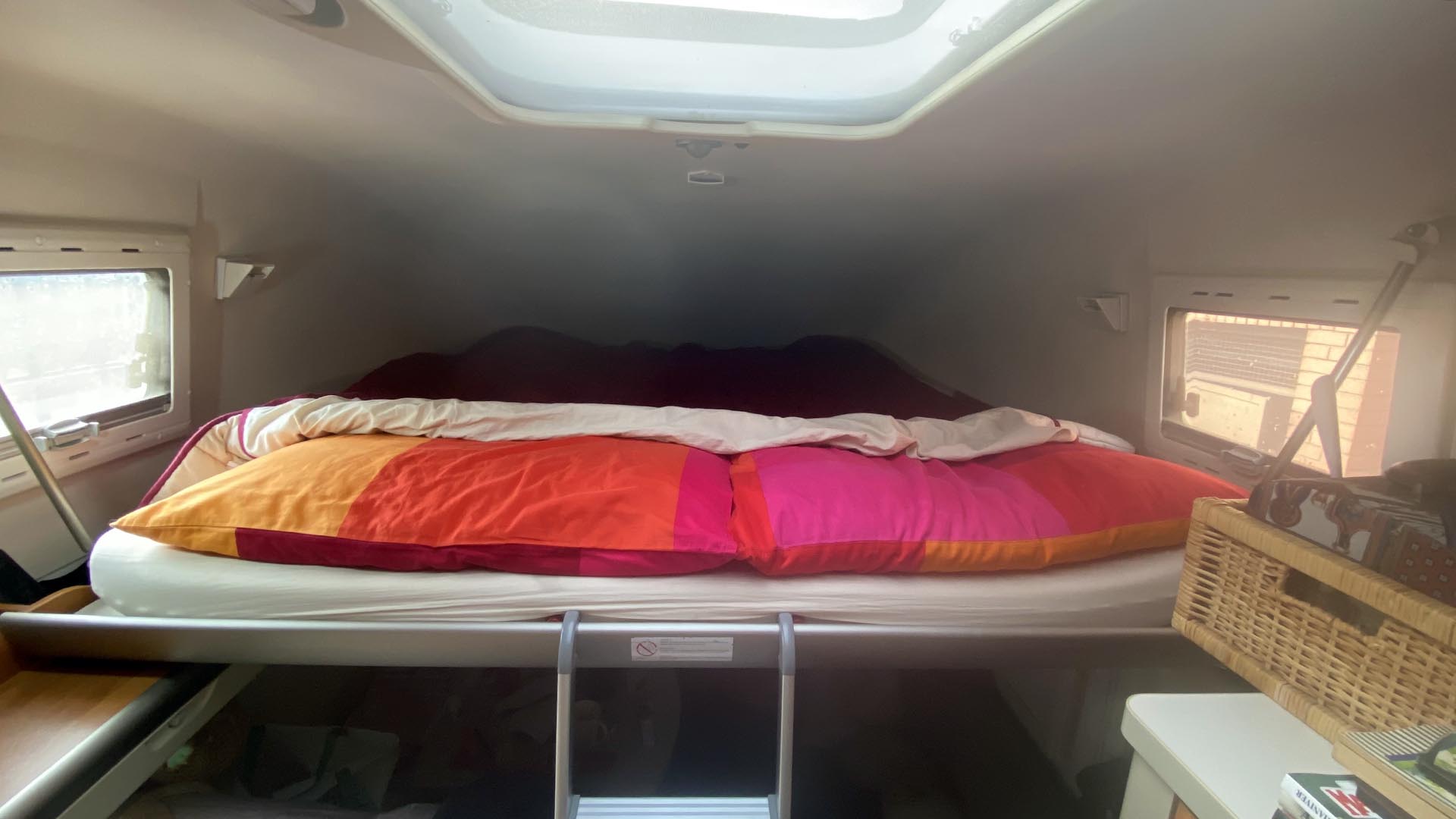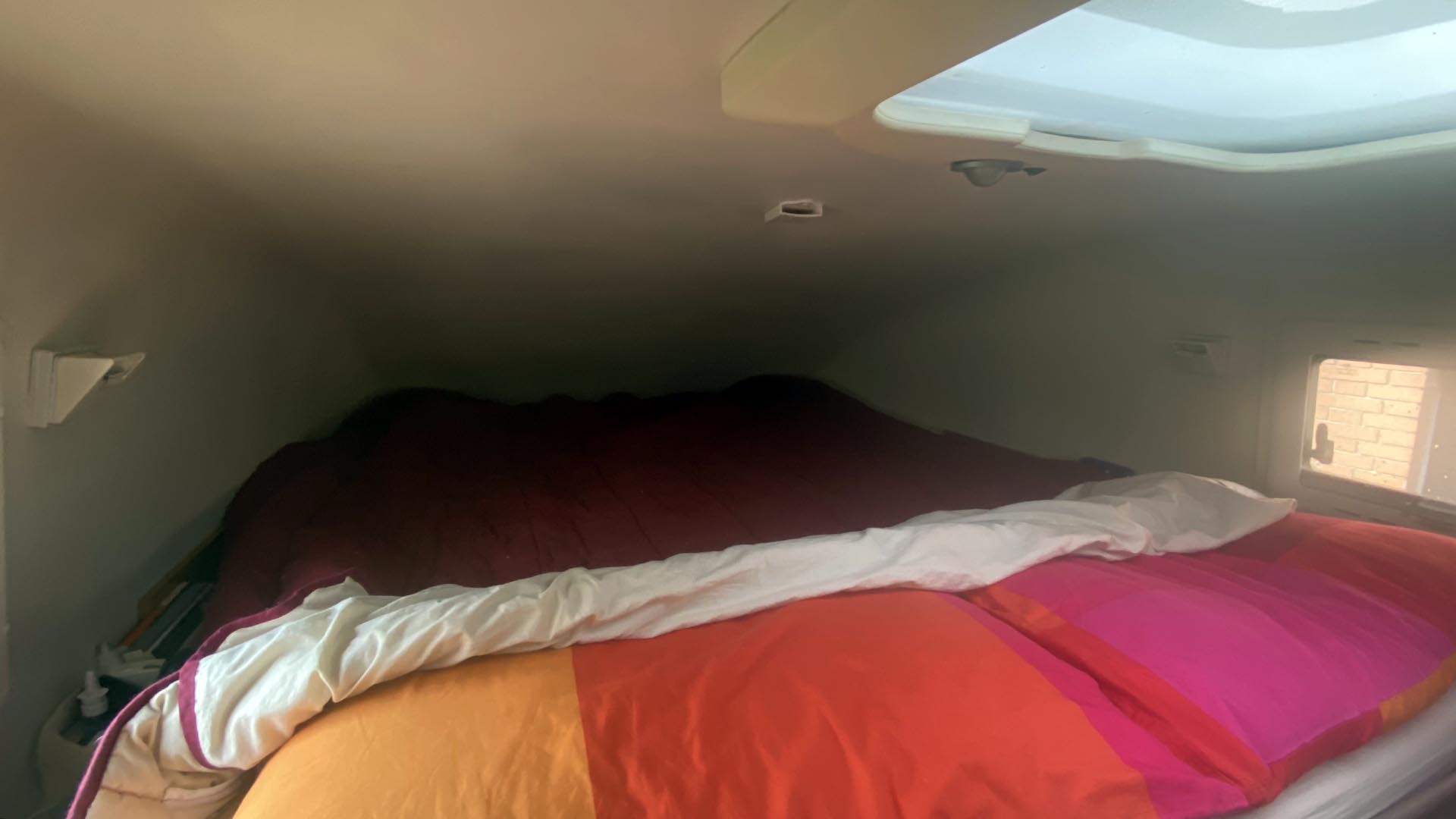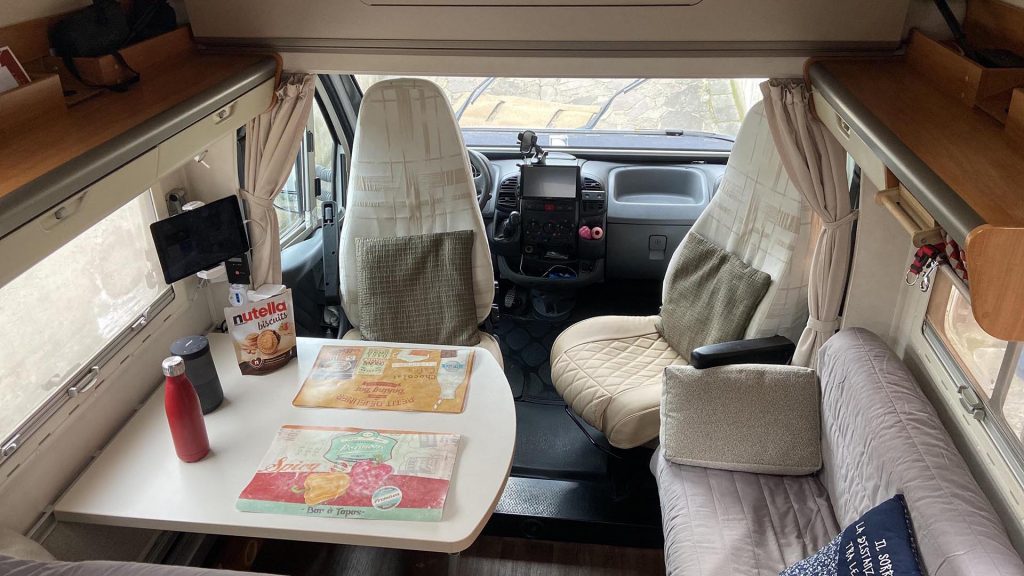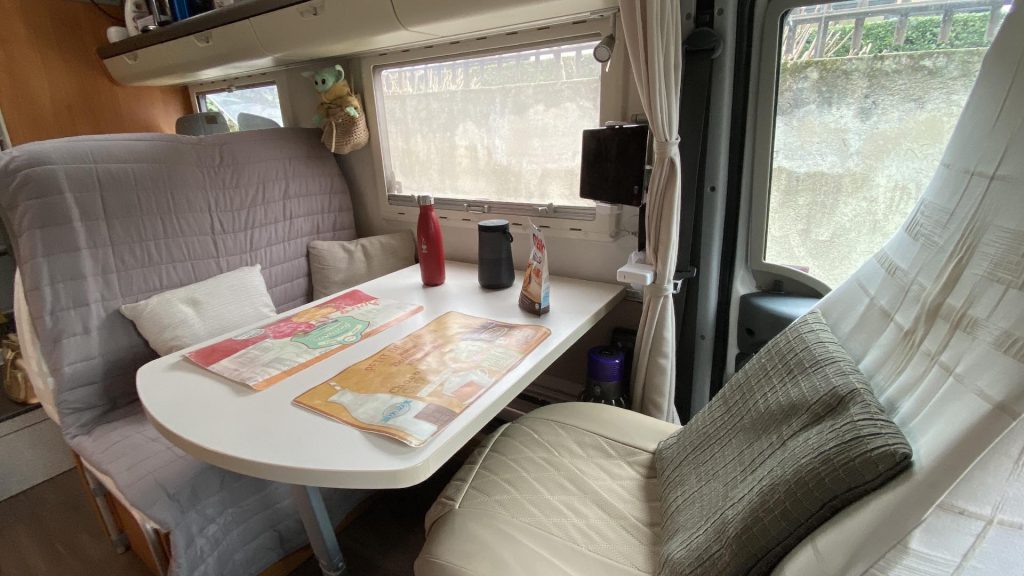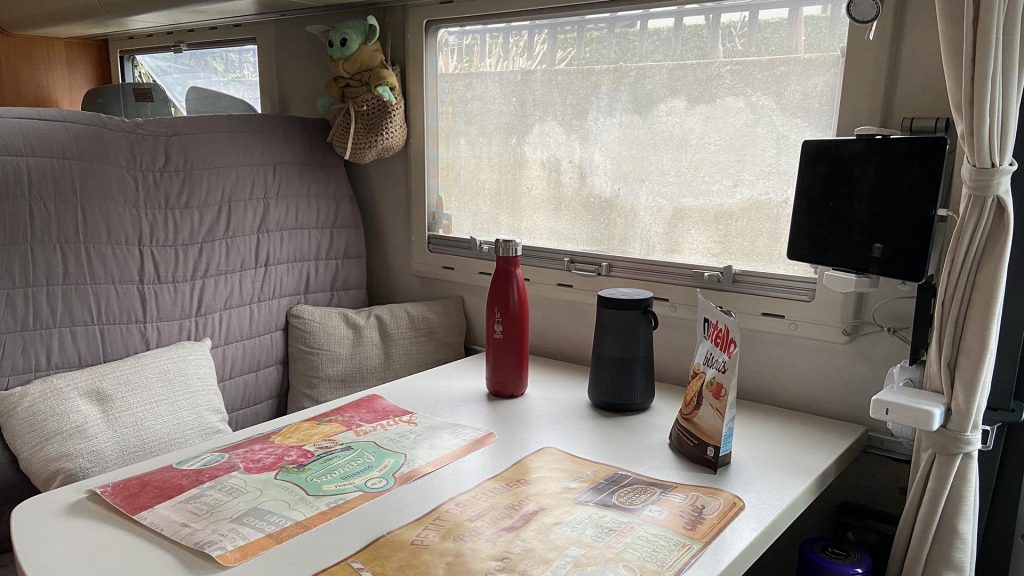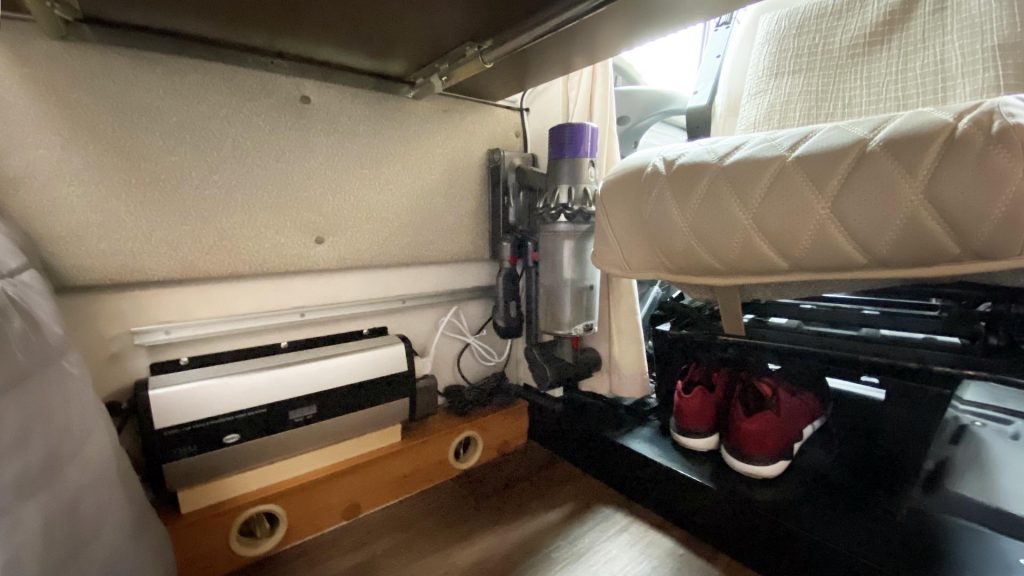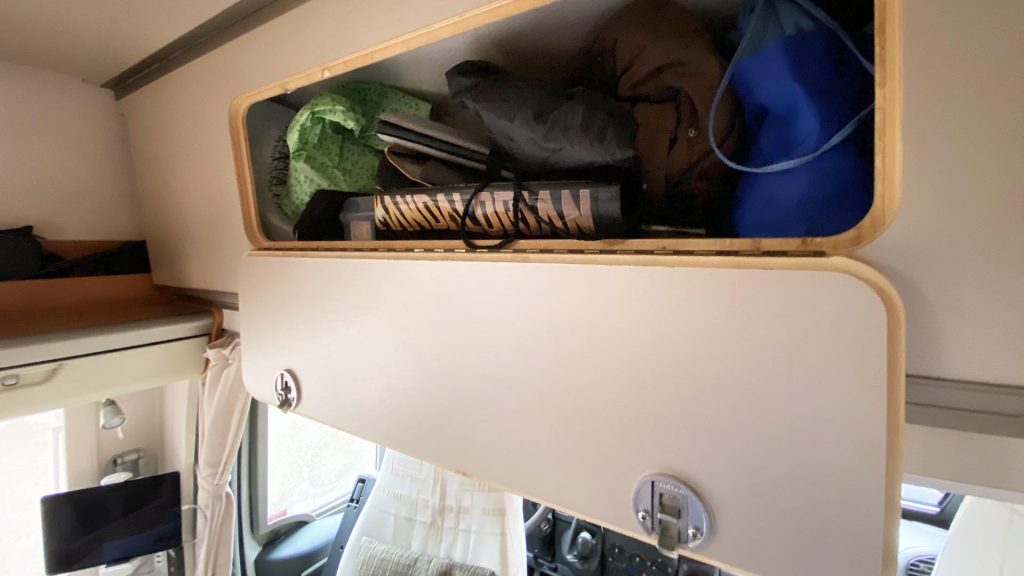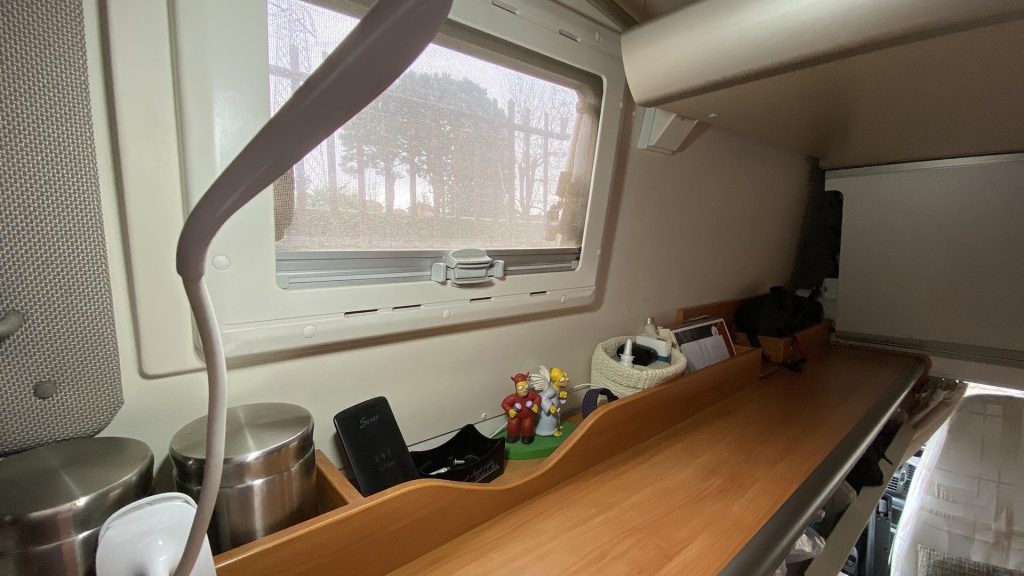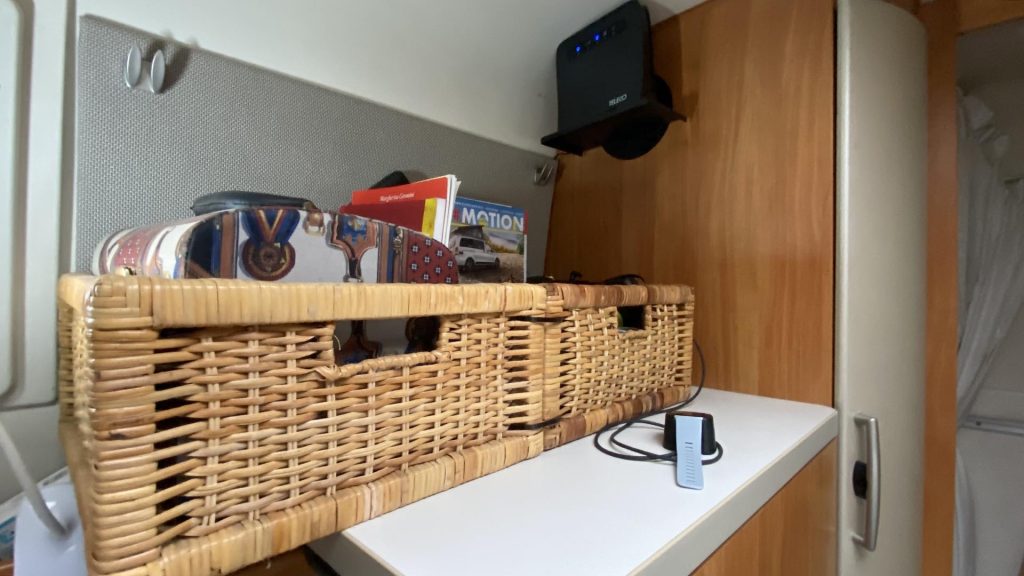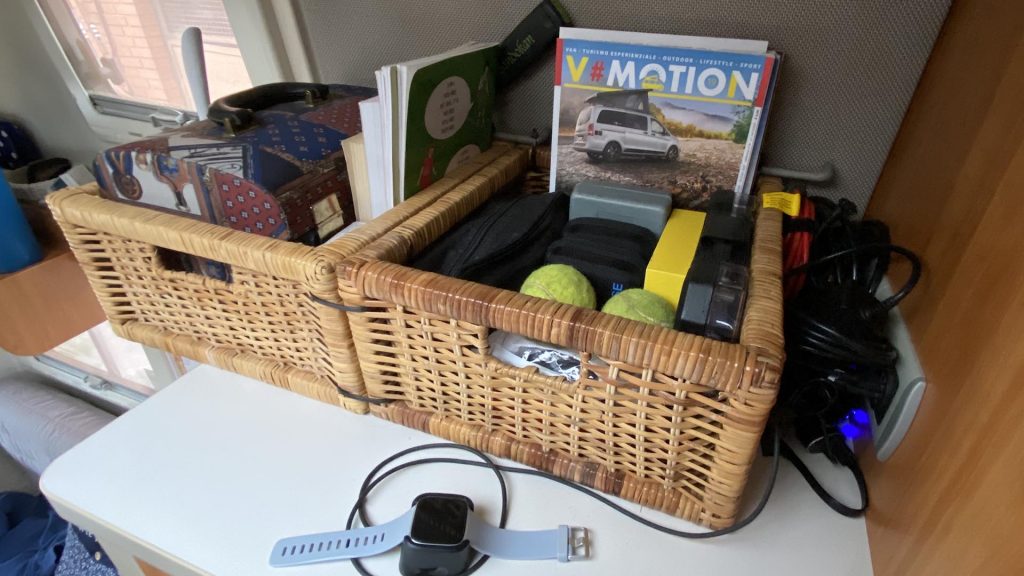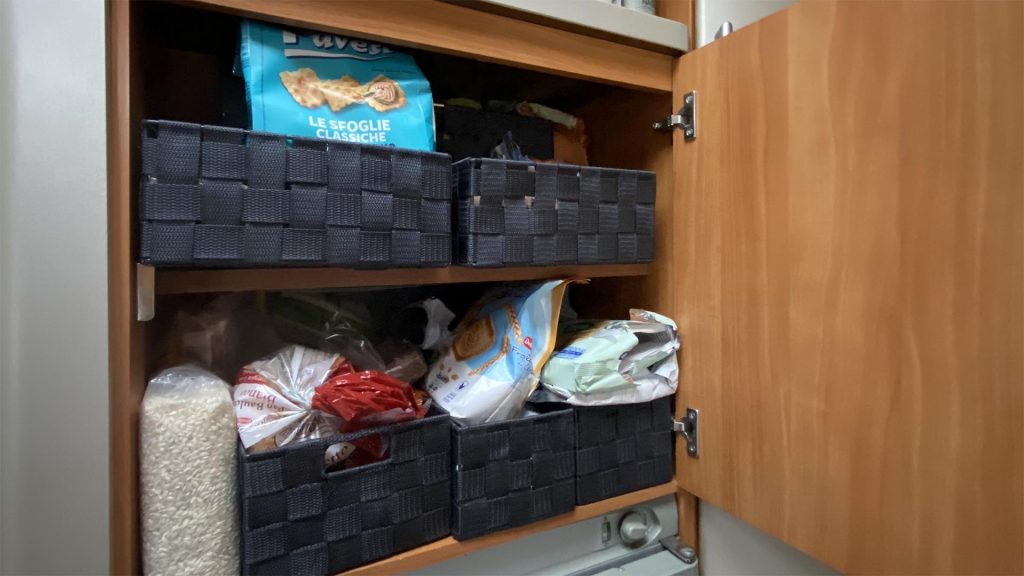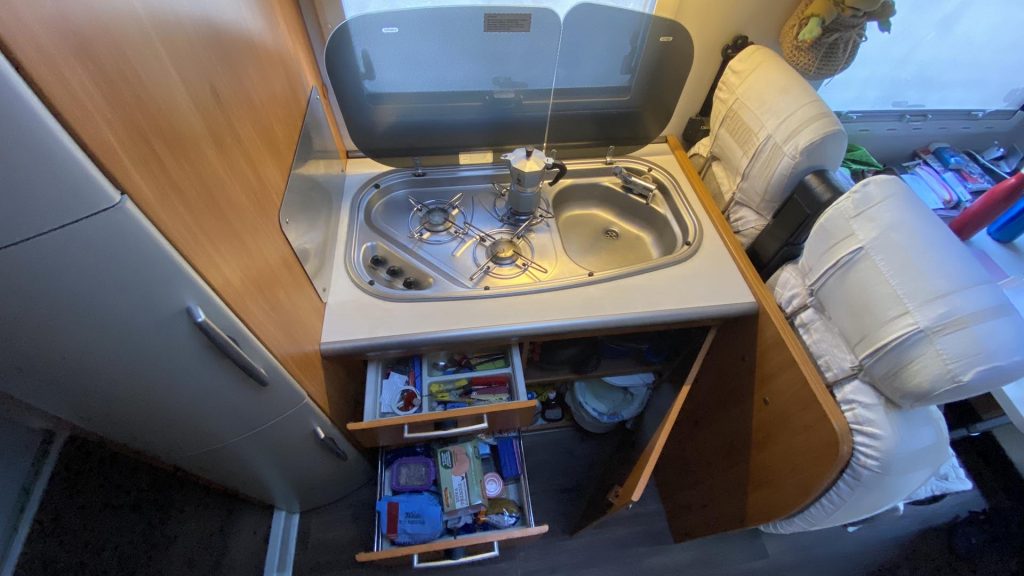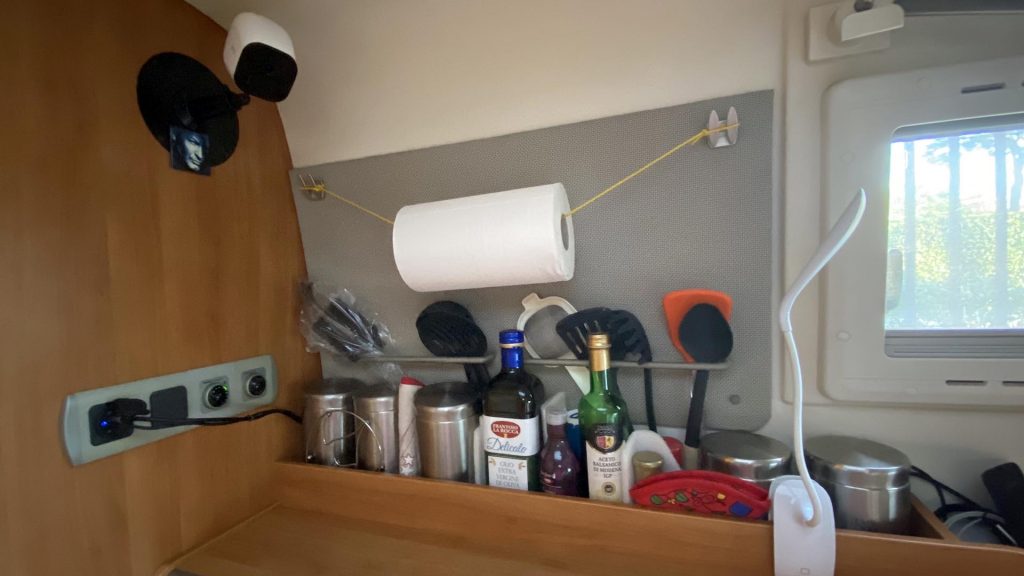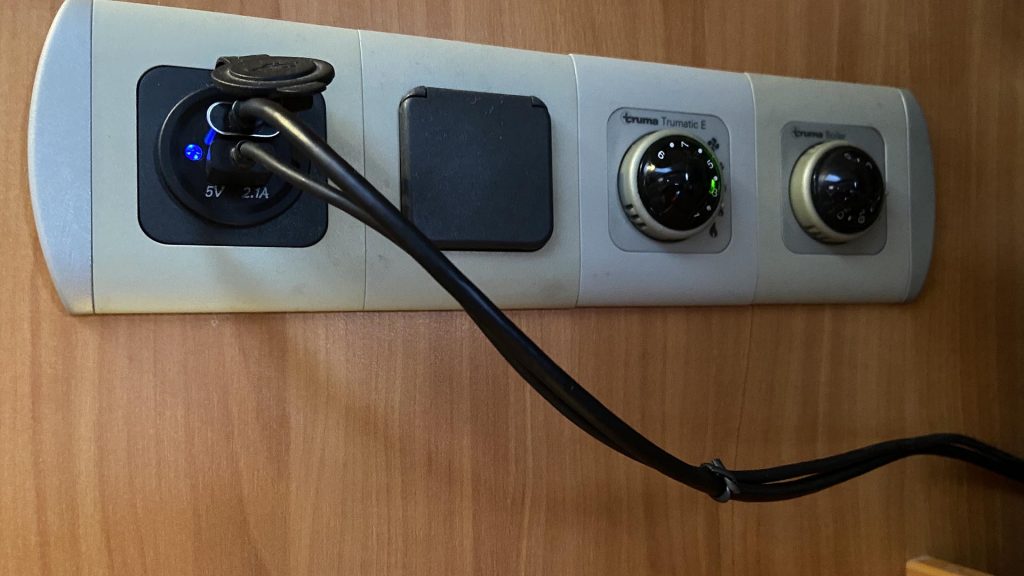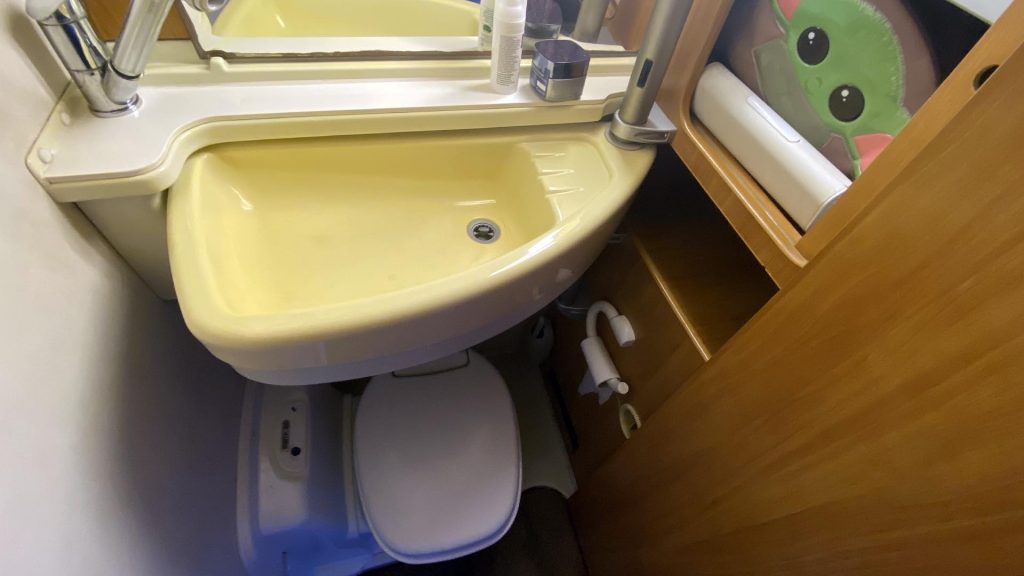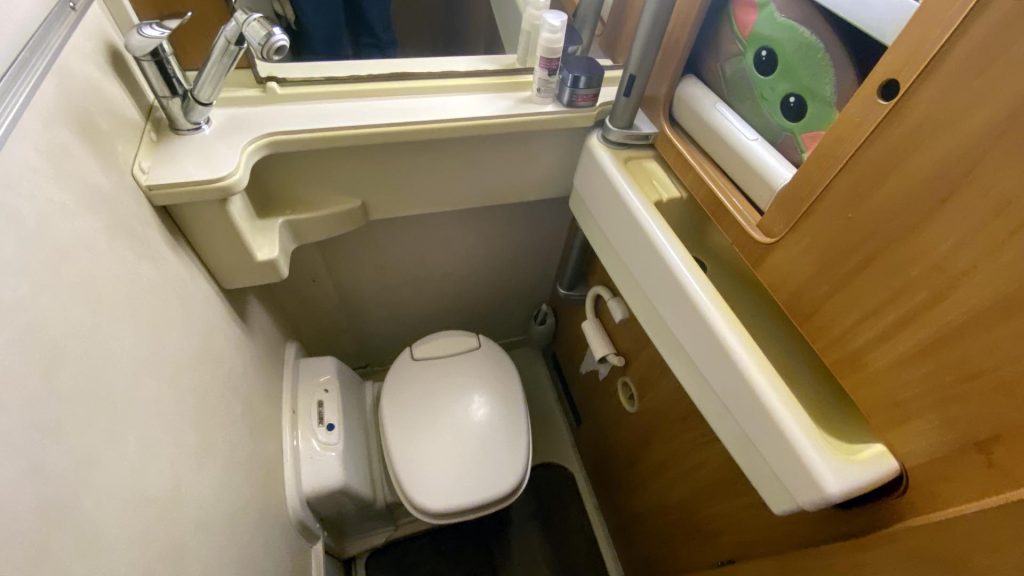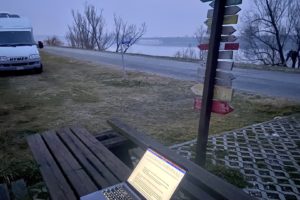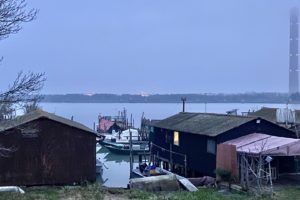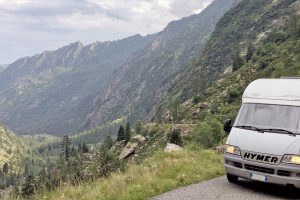
PROS
- Modern and original interior and exterior design
- Small external dimensions
- Flexible interior spaces
- Excellent stowage capacity
- Huge double bed
CONS
- Lift bed mechanism
- Uncomfortable side bench
- Limited performance
- Roof not very usable for the installation of accessories
Price (used): from €20,000 to €26,000 approximately
March 14, 2021 – We had been announcing it for a long time, but the writing proved challenging. Now you can sit back and read the complete (very long!) test of our Falkor, or the Hymer Exsis SG (first generation of the successful family of German “compact” ones) from 2005 which has been our home since June 2019. In the first part you will find the more “experiential” story written by Marilù, in the second Paolo will deal with the more technical aspects.
It was the year 2017 and, after a very short experience with the tent trailer and a longer one (four years) with the caravan, we were really fed up. Paolo saw the ad of a dealer selling a splendid 2005 Hymer Exsis SG and we immediately left for Bergamo to go and see it. And I say “see” why we weren’t going to buy it. It was love at first sight, if you can say that for a motorhome! I immediately liked everything: the aesthetics, the “airy” interior with the side bench, the huge table, the spacious bathroom, the large fold-down bed. The rest – such as engines, kilometers, tires and so on – meant little to me and I left the evaluations to Paolo.
Thus was born my “love story”, to tell the truth a bit troubled, with our Falkor. Yes, because at the beginning everything seems perfect and the holiday we did the same year (2017) in Croatia only confirmed the validity of the choice. Same thing for small trips and holidays in the mountains of Piedmont and France in 2018. Something cracked when we started to live there, to live it in everyday life and not just to make wonderful trips or weekends.
Bed: hate and love
As I mentioned earlier, the double bed of our Hymer Exis SG is foldable. A big advantage, because this allows for more living space, not only during the day, but also in the evening when one of us wants to go to sleep earlier or prefers to sleep more in the morning. In fact, the large double bed (205 x 163 cm) does not go down to the dinette, allowing you to sit comfortably in the “living room”. In addition, it leaves the kitchen area completely free if one of us wants to prepare breakfast while the other rests.
The fact that the bed goes down “a little” requires the use of a five-rung ladder: for now, there are no problems. We are still young and agile enough – especially me! – to get on and off. And, in fact, the hitch is not in this, but in the mechanism for maneuvering the bed. Paolo has no difficulty, while I can quite easily get him down, but I just can’t manage to reposition him. I find it complicated and also tiring. Dunno, will it depend on me? I do not know. The final result is that if Paolo gets up before me and leaves, I will remain with the bed lowered until he returns. And I have to be careful when I move from the bathroom and kitchen areas to that living room not to hit my head against the bed. It has even happened before! And then I think, Falkor will excuse me, how nice it would be to have a bed that can be controlled electrically: press a button and it goes down, you click it again and go up…
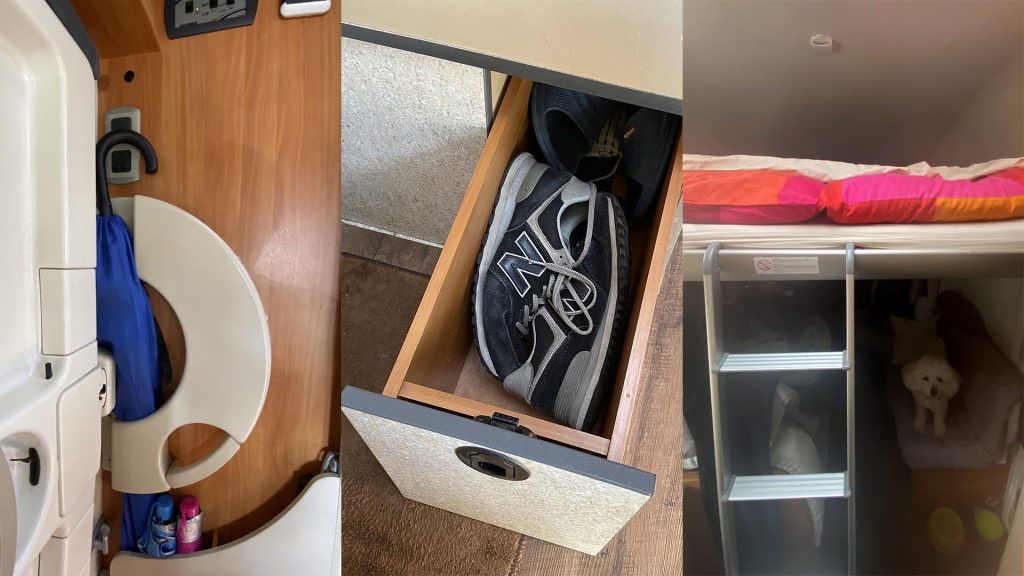
However, I must point out that the “fallback” mechanism of the three-piece bed allowed the creators of the Exis SG to create a large compartment, which is above the driver’s cabin. I think the original idea was to hide pillows and blankets but, since we always leave the bed made, it has become the storage room for bags, purses and boxes where I keep my knitting and crochet work. For those who don’t know, this is one of my passions!
A lovely living room
The living room is definitely the part I appreciate the most. There is a semi-dinette, where I always sit, a side bench – the diurnal kingdom of our Yoda – and then obviously two swivel seats, which Paolo uses. Our entire Falkor is very bright, but the living area is particularly bright, thanks to a large window on the dinette side and another behind the bench. The table is huge – especially very wide. In fact we use one side to support various objects that we need for work, and to hold the laptop when we are not using it. If desired, the table is also extendable. So, if we have one or two guests, they can eat sitting on the passenger seat and on the bench.
Another thing that I really like is the presence of many small “wall units” that open and close like the luggage compartments of airplanes. There are two of them above the semi-dinette, two above the bench, one of which is open, and the same number above the kitchen. We put a little bit of everything into it: from the stationery to a part of my underwear, from my sugar teas to Yoda’s leashes, harness and raincoat. The upper part of the wall units, basically shelves, is really very useful for placing various things on them: water bottles, fruit baskets, plates and various utensils when cooking… But we must remember to take everything off when the bed gets out, otherwise it will be a disaster. Same thing for the compartment above the driver’s cab.
Although I like the living area very much, it is not without flaws. Indeed, for me the defect is essentially one. The semidinette, where I sit to work, then using the laptop to write articles, or to do my crochet or knitting jobs, is quite comfortable even if not exactly my ideal. But the bench, which I loved at first, is instead uncomfortable. The seat is not deep enough and the back is too low. And it’s also too short to take a nap. In short, sitting for half an hour or an hour would also be fine, but sitting there while watching something on our TV-tablet is not very good. If I stretch my feet and put them on the other sofa, after a while I find myself “lying down” and, despite the additional pillows, neck and back pain are guaranteed. In the end, therefore, the bench became Yoda’s additional “bed” who, on the other hand, seems to find it very comfortable.
The kitchen: joys and sorrows
I like the cooking part overall. There are three burners, positioned at an adequate distance to use two pots or two pans, even of generous dimensions. The sink is quite large compared to others I have seen but, unfortunately, it is attached to the stove and, when we wash the dishes, splashes of water and soap inevitably end up everywhere. All things of little importance in the end! But there is one that I just don’t like. Ok the camper has its years, but it was cooked even 15 years ago. Or not? There is no sensible support surface: everything is narrow and if I try to place a plate or ladle there is always the risk that it may fall. Fortunately, above the stove, as I explained earlier, there are two small wall units and we can use the upper part to place a few things while we cook.
Given the size of our Falkor (5.45 meters), I cannot complain about the space intended for the stowage of provisions and cookware. We have a drawer for ladles and cutlery and a “chest of drawers” where we keep pasta, canned goods and condiments. In addition, under the sink there is a cabinet with two shelves: in the upper one there are pots, cups, glasses and more. In the lower one there is the dustbin and in the remaining space we put the various detergents.
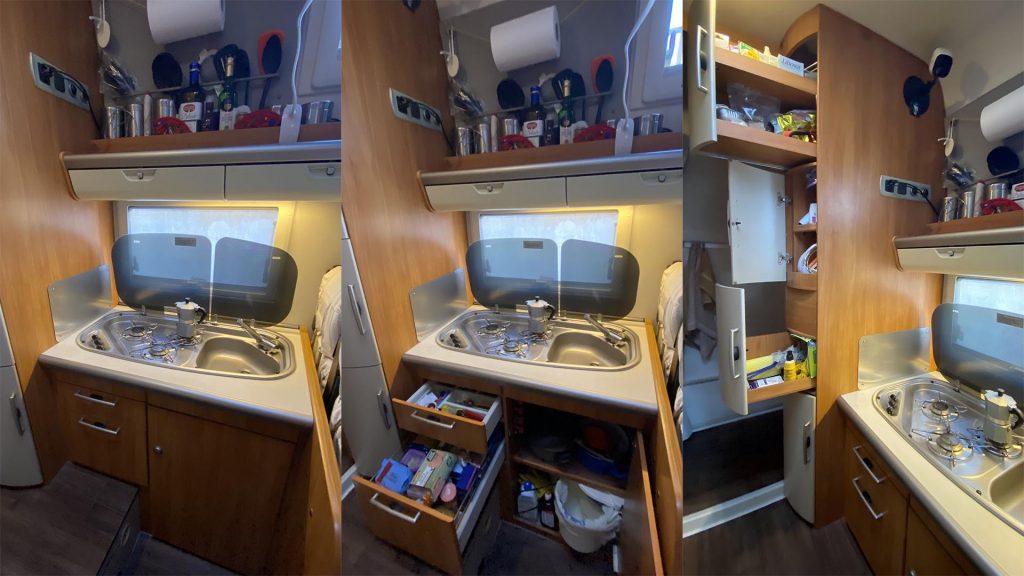
The 97-liter refrigerator, which also has a tiny freezer, is large enough. You can’t imagine how much stuff Paolo can make us stay! Right above the refrigerator there is a large cabinet. At first things were stacked and arranged in a somewhat messy way, but a year ago we bought containers of various sizes – Paolo took the measures to fit as many as possible – where we put a bit of everything: on top shower towels and bathrobes, under chips, cookies, crackers, paper tissues and so on.
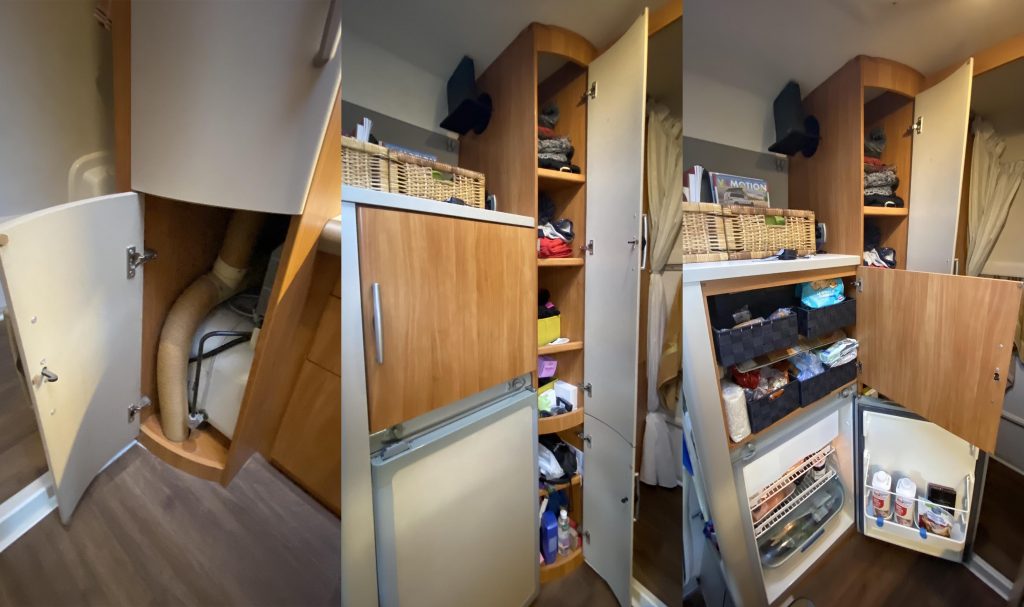
Lockers, benches, and bins
I have already said it, but I like to repeat it. In our “little” Hymer Exis SG they have done a great job, cleverly exploiting every possibility to offer maximum storage space. By lifting the lower part of the half-dinette and of the bench, where the cushions rest, you access two large “containers”. In the first, the capacity is somewhat limited by the presence of the battery, but we still have enough space to put toilet and household paper, shoes and slippers for the shower. The sneakers and slippers that Paolo usually uses are conveniently stored in the shoe drawer near the door, above which there is an equally convenient compartment where we put the umbrellas and plastic bags that we use for the dustbin.
Under the bench, on the other hand, we keep the container for the 6 water bottles, the bottles of wine, the juices, the shopping bags, the folding tray to carry the dishes to be washed and more.
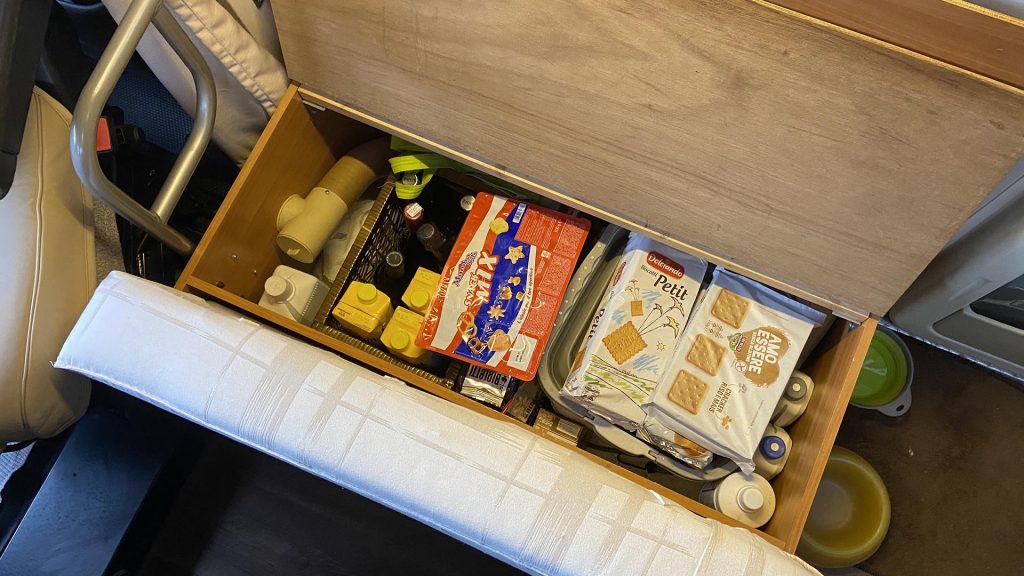
Moving past the refrigerator, we find two vertical cabinets. The first, longer, has 4 shelves where we keep the underwear, T-shirts, sweaters, pajamas. On the two shelves of the one below, on the other hand, there are various types of objects: towels, my sports equipment and so on. On the opposite side, always vertically, there are two drawers (long and narrow) and as many lockers. The lower one is unusable because it contains the stove, but in the others we have placed the cleaning products and the first aid kit, hygiene products and, finally, accessories and dry food for Yoda.
A large bathroom
At the rear of our Hymer Exis SG there is the bathroom (transversal), which also houses the wardrobe. But we will see the latter later. To create a locker in the rear, the whole area that goes from the middle of the kitchen to the bottom of the camper is raised. The advantage is that we have additional storage space available (tools, power cable, etc.). The disadvantage? We have to deal with a significant difference in height (30 centimeters) between the front and the rear of Falkor. In addition, you must also pay attention to the shower tray with the raised edge. It goes without saying that every time you access the closet or go to the bathroom, you must necessarily climb the “step”. And being two in the kitchen is just impossible.
The bathroom/wardrobe closes with a folding door which, when not needed, can be locked from the inside to create a single room. As soon as you enter the bathroom, you put your feet on the shower tray. Not exactly the best! At the beginning there was a rubberized mat (yellow!) cut to size. Legacy of the previous owner, but not a very practical solution. It got dirty easily and had to be washed in the washing machine. It was also perforated and the dirt penetrated, ending up on the shower tray. We have solved, at least temporarily, by making a wooden platform, which is rather heavy and not easy to remove and put on when taking a shower.
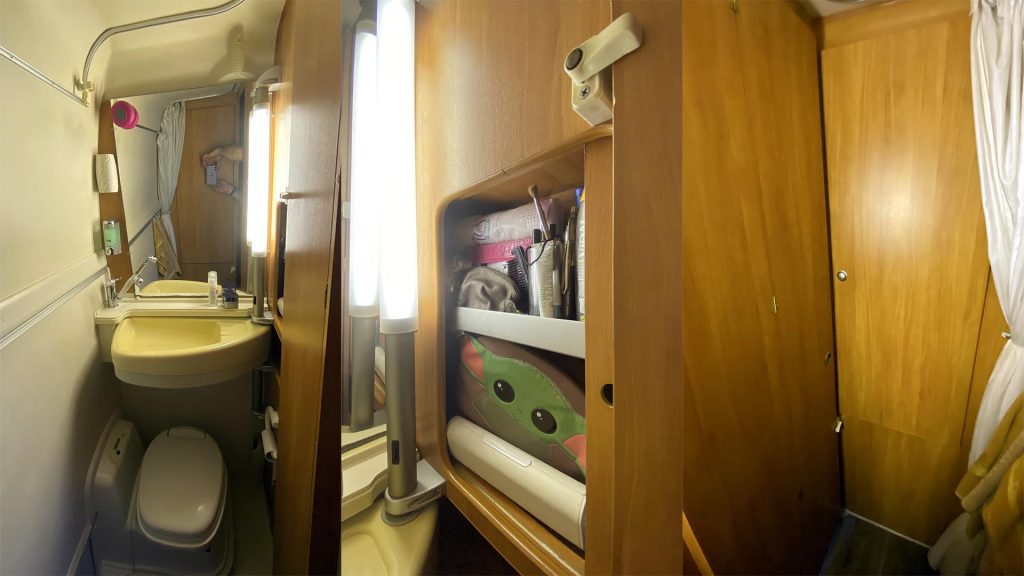
On the right of the toilet room there is the revolving sink, which, once the bathroom door is closed, moves towards a special compartment to allow us to use the toilet. There is also a small shelf and a large mirror. The skyroof takes care of the ventilation. The bathroom is beautiful and also large, but the fact of removing and putting on the platform and the fact of having to remove the hand shower from the compartment on the sink are very, very uncomfortable. And they make an operation as pleasant as a shower, a little less relaxing!
The wardrobe and closet
Entering the toilet room, as I had already mentioned, you will find the wardrobe on the left. The lower part is higher on one side (below is the water tank) and lower on the other (the cylinders are below). In this recess we keep the basket of dirty laundry and, in layers, the backpacks, the oven, the large frying pan, the basin for the bidet. On top of everything, then, we put two plastic containers with lids to contain various items of clothing. A clothes rail for jackets, trousers, dresses, long sweaters and so on runs along the entire width of the wardrobe.
Paolo the technician
Everything you have read so far has been written by Maria Luisa. Her attention went to the “experiential” aspect of our life on Falkor, but a test cannot be said to be complete without mentioning the technical aspect as well. So, here’s a final addition from me (Paolo).
Let’s start with the heating system, which is important in many ways. Falkor has a Trumatic 4000C stove and a 10-liter boiler of the same brand, both powered by gas. At their service, as well as that of the stoves and the 3-way fridge (i.e. able to operate, with manual selection, at 230 Volt when connected to the electricity network, with gas in free parking and 12 Volt when traveling), there is compartment capable of accommodating two 11 kg cylinders. We use the classic steel ones because they are easier to find, but fiberglass containers would also fit easily into that space.
The two cylinders are a suitable choice for the size and type of vehicle. The excellent insulation of the Exsis allows us to have reasonable consumption. In February, when the temperatures here near Milan often drop a few degrees below zero, with a cylinder we can last between 6 and 8 days: an excellent result considering that we are in the motorhome almost constantly, which during the day we keep between 20 and 21 degrees and that at night we stay around 16. What would be the ideal solution? Alongside a diesel system, we are thinking of an Eberspächer, and adopt a double-chamber refillable cylinder (we talked about it here), keeping only one normal cylinder. This would guarantee us maximum flexibility. In the meantime, we have just installed the Truma DuoControl CS with the corresponding filters in order not to find ourselves, as often happens, without heating in the middle of the night.
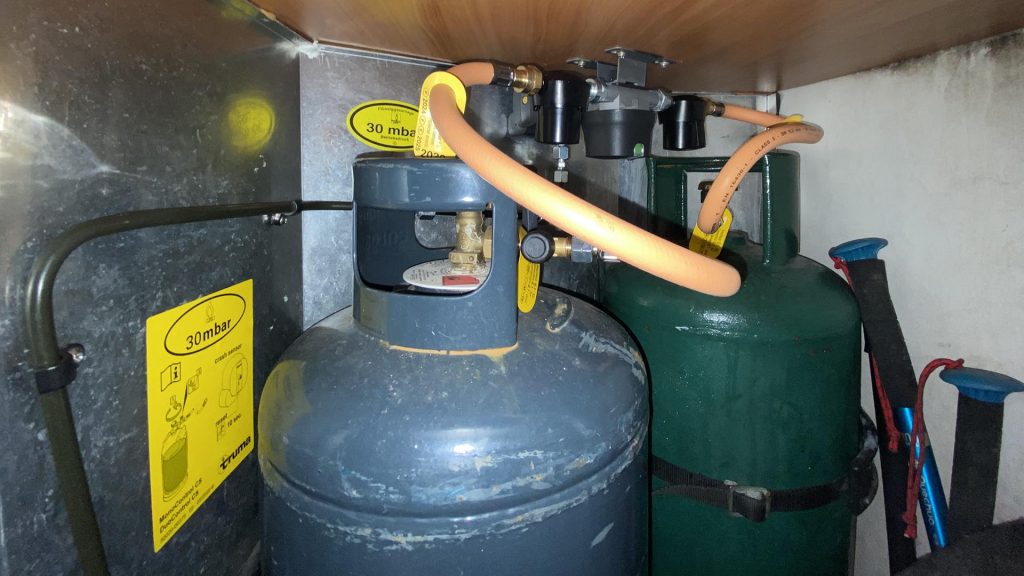
Beware of water
From the water point of view, Falkor is based on a 100-liter drinking water reserve. The tank located in the cabinet can be easily inspected, but its height makes it difficult to clean the bottom: you can’t reach it with your arms. The immersion pump, 19 liters per minute, is easy to find and quick to replace if necessary. As for the gray water, the capacity is only 75 liters and so the waste tank fills up completely before the clear water approaches the end and the overflow valve unfortunately unloads inside the vehicle. We must therefore be careful. The great advantage, however, is that the container is located inside the cell, completely protected from bad weather and cold.
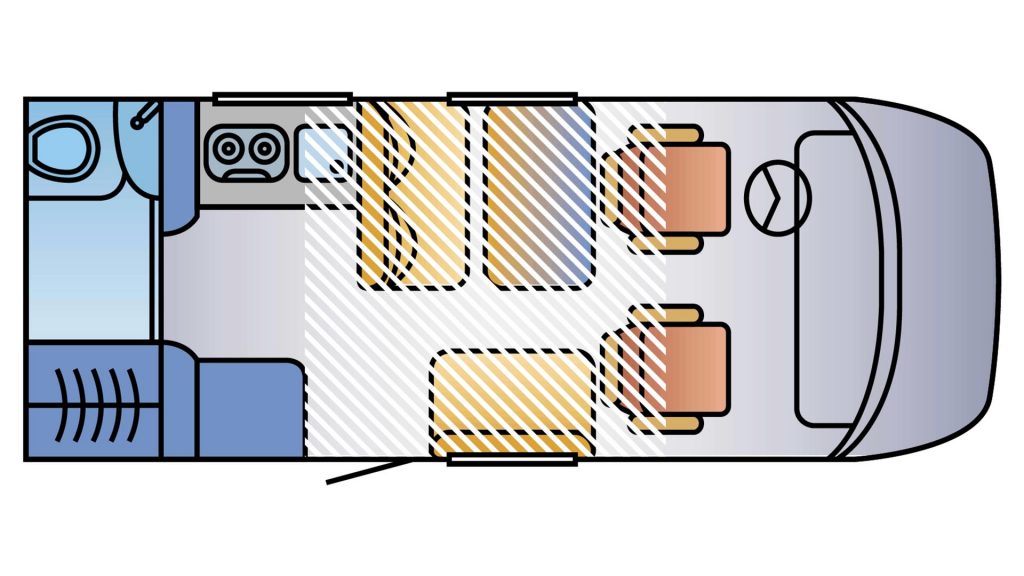
A weak point of the Exsis is the surface available on the roof (walkable). The rounded shape and the presence of a maxi-central skyroof (80 by 50 cm) and a skyroof in the bathroom makes the installation of accessories complicated. A satellite antenna can be accommodated quite easily on the back, but an air conditioner is impossible to assemble without giving up the large skyroof and proceeding with a complex reconstruction of the missing roof portion. The curvature of the roof also makes it difficult to adopt photovoltaic modules: rigid ones are often an eyesore from an aesthetic point of view and therefore perhaps it is better to think of flexible solutions. We are still in the planning stage.
A great road racer
A few words about mechanics. Falkor relies on the Fiat Ducato with a 2.3-liter engine and 110 horsepower (at the time the best performing 127 horsepower was also available). When we bought it, it already had 185,000 kilometers, but our assessment has been (and so far with good reason) that these vehicles were born to achieve much greater mileage without too many problems. Since then we have done 35,000 kilometers and maintenance has been limited to two standard services (oil and filters), a front and rear pad change, a belt change with water pump kit (the second in Falkor’s life) and a tire change, which were already very worn. The only “failures” were a problem of loose alternator connections, which caused us some concern, but which was solved with a careful check, and the replacement of an excessively worn wheel bearing.
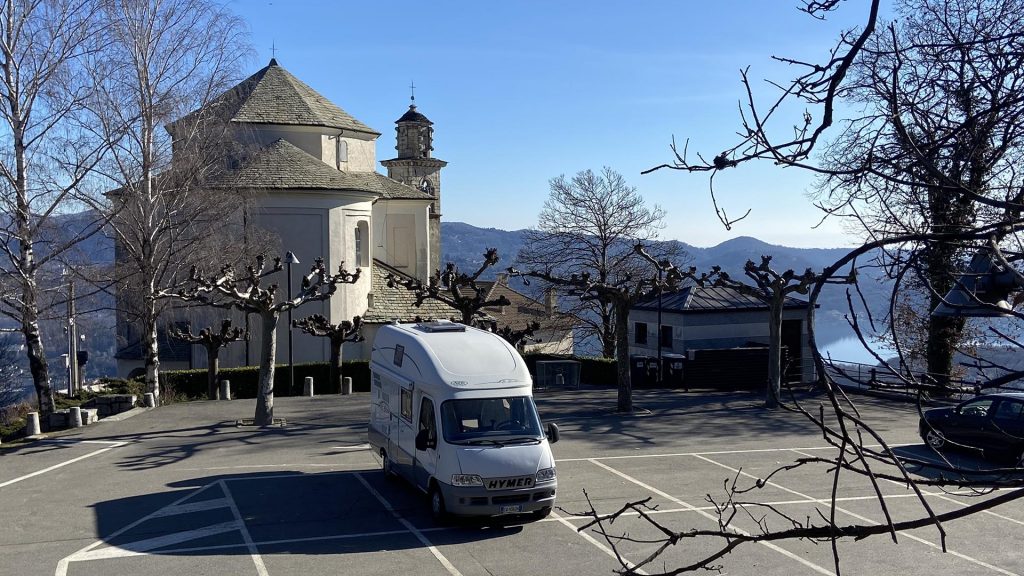
Speaking of performance, our Hymer Exsis SG is not a “lightning bolt of war”: acceleration and recovery are modest, given the few cavalry available, but on the other hand, consumption is excellent. Despite a height of 305 centimeters, on average we covered 11.5 kilometers with one liter. Our standard pace on the motorway, where we have covered more than two thirds of our kilometers, is just above the 110 km/h speedometer, taking into account that we measured a deviation of about 10% from the real speed. Still talking about the speedometer, Falkor easily reaches over 140, but considering the height of the vehicle and the age of the suspension, we love to travel a little more relaxed. Also thanks to the presence of an accessory that we consider fundamental: the cruise control.
Hard to find
Finally, if you like this Hymer, some information on its availability and versions. This is a fairly rare vehicle, which was only mass-produced from the end of 2003 to the beginning of 2006. It is estimated that there are around 600 pieces in all. When Fiat changed the chassis from the Ducato x244 to the Ducato x250, Hymer did not consider it convenient to redo the molds of the roof and the front shell, thus leaving a splendid idea to “die”. In addition to the arrangement you see on Falkor, there were also the SK version (with a face-to-face dinette with central table and a slightly longer kitchen module) and Vario (instead of the benches there were two single armchairs). The versions with the robotic gearbox are very rare.
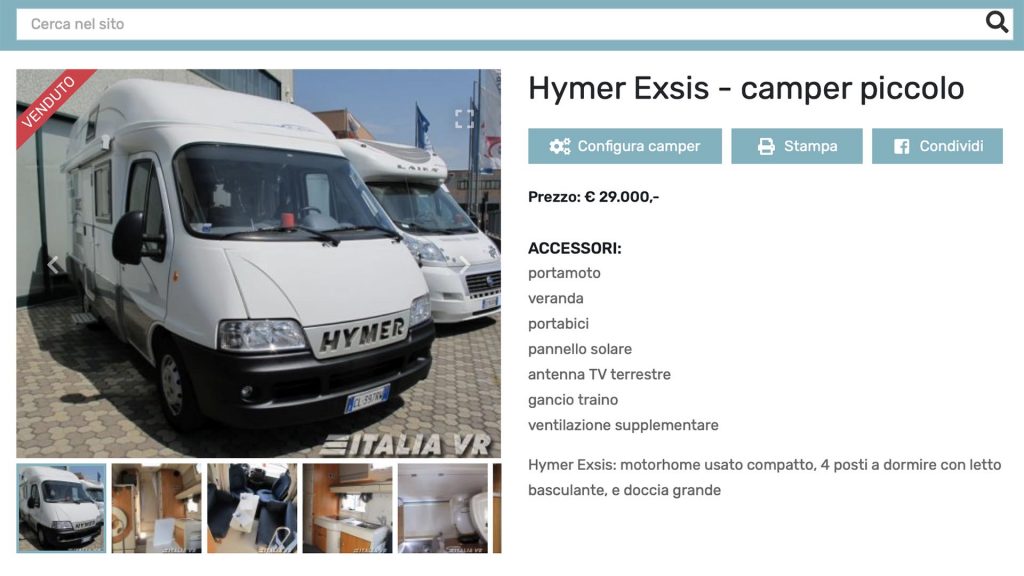
The first generation of the Hymer Exsis is sought after as used throughout Europe, with potential buyers who often travel to countries other than their own to complete the purchase. The prices range from 20 to 26 thousand euros approximately. In the wake of the success recorded by motorhomes in 2020, today someone tries to ask for more, but we do not know if the negotiation will be successful.
As you have guessed, in 545 centimeters in length there is really everything. It should be emphasized that, in addition to the length that allows you to park (almost always) remaining within the limits of the stalls made for cars, the width also plays its part: the 205 centimeters of Falkor are the same as the body of the van and allow both to park more easily in comb or fishbone spaces and to pass on roads where wider vehicles would have difficulty or even could not pass. Finally, the wheelbase of only 3,200 millimeters (the current 541-centimeter Ducato has a 3,450-millimeter wheelbase) gives the Exsis a handling unknown even to today’s vans.
We often think of the possibility of changing vehicles, but in addition to the fact that the economic situation would not allow it easily, it must also be said that there are not many means capable of summarizing Falkor’s contents so well. Unless we think of very different dimensions, but in this case the “Seimetri” philosophy would fall.
The technical data sheet of our vehicle (2005 price list)
- Brand and model: Hymer Exsis SG
- Typology: hybrid semiintegrated/integrated
- Roof: high in double-shell fiberglass
- Length-width-height dimensions: 545 x 205 x 305 cm
- Travel/sleeping places: 4/2 + 2
- Mass in running order: 2.795 kg
- Fully loaded mass: 3.500 kg
- Loading capacity: 705 kg
- Falkor weight (full loaded, 06/06/2019): 3.180 kg
- Optional fully laden mass: 3.850 o 3.900 kg
- Chassis, displacement/power: Ducato 15, 2,3l/110 HP
- Other chassis: Ducato 11 2,0l/85 HP, Ducato 15 2,0l or 2,8l/127 HP, Ducato 18 2,8l/127 HP or 2,8l/146 HP
- Low frame: no
- Air conditioning: optional (1.392€), installed on Falkor
- Cruise control: optional (290€), installed on Falkor
- Passenger airbag: optional (696€)
- Fog lights: no
- 16-inch wheels: optional (790€)
- Radio: optional (695€)
- Rear camera: optional (1.090€)
- Automatic gearbox: available with Ducato 15 or 18 chassis and 2.8l/127 HP engine
- Construction type: sandwich with external aluminum and wood-free walls
- Floor/wall/roof thicknesses: 30/30/30 mm
- Double floor: partial, in the back
- Main bed size: 205 x 163 cm
- Transformable dinette bed: 189 x 130/90 cm
- Minimum internal height: 190 cm
- Cockpit blinds: optional (395€), installed on Falkor
- Door with mosquito net: no
- Central locking: yes (optional on cell door: 395€)
- Front skylight: no
- Heating: Truma Trumatic 4000 on gas + Boiler 10-liters on gas
- Cooker: with three burners, manual ignition
- Refrigerator: 3-way 60-litres (optional 97-litres, 395€, installed on Falkor)
- Gas cylinders: 2 x 11 kg
- Shower: integrated
- Service battery: 80Ah
- Drinkable watr: 100-litres
- Grey water: 75-litres
- Gray insulation: yes, in double floor
- Electric step: yes
- Heated floor: no
- Garage: no
- Price starting from: €43.900
- Falkor price, including drop-down bike racks and awning: €49.897
©2021 seimetri.it – If you want to leave a comment on this article, you can do it on our Facebook page







